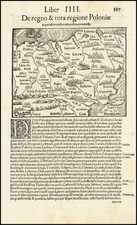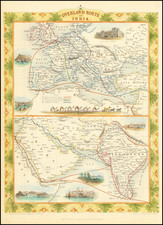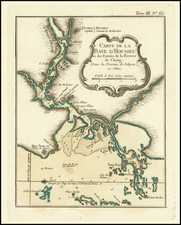First Edition of Strahlenberg's Seminal Work on Russia, bound with an English Edition of the Map
Nice example of the London edition of Strahlenberg's map of Russia, one of the most important maps of Russia published in the 18th century, bound with the original 1730 Stockholm edition of Strahlenberg's Das Nord- und Ostliche Theil von Europa und Asia . . .
Book Description: [26],,438, [16] pp. With folding woodcut map; 10 engraved plates & plans, 3 of them folding; folding letterpress table on 2 sheets joined; several full-page woodcut illustrations. Large folding copper-engraved map by R.W. Seale, from the English edition of the book, bound in at rear. (4to) 22.6x18 cm (9x7"), period half vellum & marbled boards. First Edition. The author states that the map was too large to bind with the book, but that a copy of the map on thin paper in four sheets could be obtained and be bound with the book. The map is lacking wanting, but curiously this example includes the 1737 English version of the map, which is nearly identical to the original, other than the addition of "R.W. Seale Sculp. 1737" at the bottom right corner.
Strahlenberg's work includes a very important map of Russia, particularly for Siberia and Central Asia. The map was engraved by Ferdinand Hilfreich Frisch in Berlin and published separately, as a companion to Strahlenberg's Das Nord- und Ostliche Theil von Europa und Asia . . . . As noted by Bagrow:
It is to be regretted that Strahlenberg's map has so far not been studied to any large extent. After Remezov, it is the second most important source of historical geographical information about Siberia. Yet it did not have a great influence on maps of the following period and, in a way, stands apart.
Strahlenberg, whose name was Tabbert before he was ennobled in 1707, was an officer and cartographer born in Stralsund. After the Swedish defeat in Poltava in 1709 Strahlenberg, a Swedish officer, was taken prisoner during Charles XII's campaign in Russia and held captive in Siberia for thirteen years. Imprisoned in Tobolsk from 1711 to 1721, he was able to explore the lower basins of the Ob and Yenisey rivers, gathering the geographical information regarding the northern and eastern parts of Europe and Asia recorded in this large map. This important map is based on his travels and extensive research in Russia. He returned to Sweden in 1722.
Strahlenberg's work is of great importance offering much first-hand information, geographical, historical and ethnographic, about Siberia and Great Tartary. His book also includes early descriptions of the linguistics of the region, with a Kalmyv vocabulary including the translations of Mongolian words. The most important aspect of his work was unquestionably his rare and significant map representing the Russian realm and Great Tartary, containing extensive information regarding Siberia.
Strahlenberg utilized a wide array of sources in preparing his map. He used his own latitude calculations, as well as readings he had taken with Daniel Gottlieb Messerschmidt, a Prussian naturalist with whom he travelled in Russia. Measurements and other geographic information were obtained from other sources as well, including Swedish officers on different expeditions, Swedish and German travelers, and Russian cartographers and explorers.
The map encompasses the area between 50° and 185° east longitude and 32° and 75° north latitude. It records the Russian territories from west of Moscow to Japan in the east and includes northern China, Tibet, and Turkestan in the south. Neighboring countries such as Poland, Persia, India, and Mongolia are documented. Numerous important geographic features are also represented: the Arctic and Pacific oceans, and the Caspian Sea; the Urals, Caucasus, and the Himalayan mountains; and the Gobi desert. The map is most notable, however, for its accurate representation of Siberia, particularly the settlement patterns of the region's various populations.
The map was later re-engraved for English editions of the book by R.W. Seale, which is nearly identical to the original Berlin edition, other than addition of Seale's name and date at the bottom right corner.
The map is one of the most important and collectable maps of Russia published in the 18th century and an essential map for Russian and Northeast Passage map collectors.















![(American Revolution) Geschichte der Revolution von Nord-America. Sammlung der besten Schriftsteller, welche die Geschichte, besondere Rechten, Sitten, und Gewohnheiten der Völker nach ihren Grundsätzen abgehandelt haben [with map:] Die Vereinigten Staaten von Nord=America. nach der Wm. Faden 1783. [History of the Revolution of North America. Collection of the Best Writers Who Have Discussed the History, Specific Laws, Customs, and Habits of the Peoples According to Their Principles [with map:] The United States of North America. According to Wm. Faden, 1783.]](https://storage.googleapis.com/raremaps/img/small/90124.jpg)
![[ New France - Pierre Biard's Letter ] Missio Canadensis [in] Annuæ Litteræ Societatis Jesu Anni MDC.XI.](https://storage.googleapis.com/raremaps/img/small/84352.jpg)